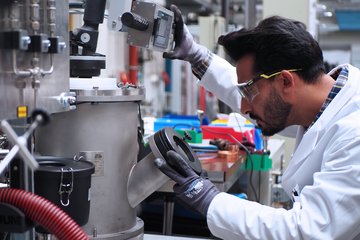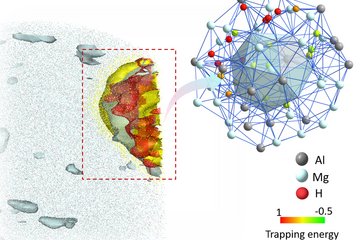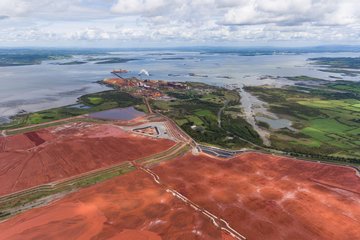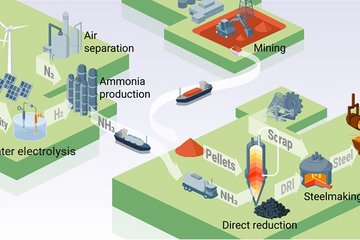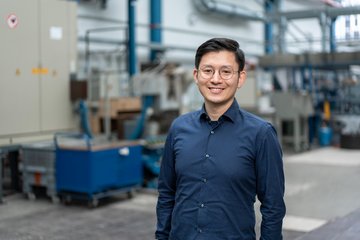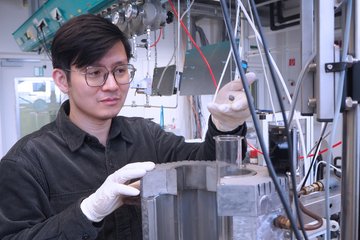Alle Typen
21.
Zeitschriftenartikel
Strain hardening engineering via grain size control in laser powder-bed fusion. Materials Science and Engineering A: Structural Materials Properties Microstructure and Processing 838, 142773 (2022)
22.
Zeitschriftenartikel
Recrystallization in non-conventional microstructures of 316L stainless steel produced via laser powder-bed fusion: effect of particle coarsening kinetics. Journal of Materials Science 57, S. 9576 - 9598 (2022)
23.
Zeitschriftenartikel
Recrystallization kinetics, mechanisms, and topology in alloys processed by laser powder-bed fusion: AISI 316L stainless steel as example. Materialia 20, 101236 (2021)
24.
Zeitschriftenartikel
The origin of abnormal grain growth upon thermomechanical processing of laser powder-bed fusion alloys. Materialia 20, 101243 (2021)
25.
Zeitschriftenartikel
Laser Powder-Bed Fusion as an Alloy Development Tool: Parameter Selection for In-Situ Alloying Using Elemental Powders. Materials 13 (18), 3922 (2020)
26.
Vortrag
In-situ insights into interfacial processes at reactive liquid-solid interface during magnesium corrosion using cryo-atom probe tomography. EuroMat 2025 conference, Granada, Spain (2025)
27.
Vortrag
Using in-situ metallic coating to overcome challenges in analyzing poorly conductive and brittle fragile samples by atom probe tomography. 5th European APT Workshop, Marseille, France (2025)
28.
Vortrag
New insights into the reactive liquid-solid interface during magnesium corrosion using cryo-atom probe tomography. EUROCORR 2025 Annular Congress of the European Federation of Corrosion, Stavanger, Norway (2025)
29.
Vortrag
cryo-atom probe tomography; quasi-'in situ' analysis of the reactive liquid-solid interface during Mg corrosion. 16th Biometal 2024 Symposium, Krakow, Poland (2024)
30.
Vortrag
cryo-atom probe tomography; quasi-'in situ' analysis of the reactive liquid-solid interface during Mg corrosion. 9th NRW-APT user meeting, MPIE, Düsseldorf, Germany (2024)
31.
Vortrag
Grain boundary-controlled lithiation of Li-solid solution systems for lithium metal batteries. International Operando Battery Days, Grenoble, France (2024)
32.
Vortrag
In-situ cryogenic protective layers and metal coatings in cryogenic FIB. IMC20 - 20th International Microscopy Congress - Pre-congress workshop, Cryogenic Atom Probe Tomography, Busan, South Korea (2023)
33.
Vortrag
Site-specific preparation and atom probe tomography of bulk water ice and amino acid solutions. Atom Probe Tomography & Microscopy, Leuven, Belgium (2023)
34.
Vortrag
Site-specific preparation and atom probe tomography of frozen liquids. IMC20 - 20th International Microscopy Congress, Busan, South Korea (2023)
35.
Vortrag
GIS-free metal coating in cryo-FIB: methods and use cases. IMC20 - 20th International Microscopy Congress, Busan, South Korea (2023)
36.
Vortrag
APT towards liquid-solid interfaces to study early-stage corrosion mechansim. 9th NRW-APT user meeting, Düsseldorf, Germany (2023)
37.
Vortrag
Observations on Improved Cryogenic Lift-Out Methods: Optimised Sample Preparation. Talk at Korea Institute of Science and Technology, Seoul, South Korea (2023)
38.
Poster
cryo-atom probe tomography; quasi-'in situ' analysis of the reactive liquid-solid interface during Mg corrosion. 16th Biometal 2024 Symposium, Krakow, Poland (2024)
39.
Poster
Analysis of the reactive solid-liquid interface during the corrosion of magnesium at the near atomic level using cryo-atom probe tomography. Aqueous Corrosion Gordon Research Conference (GRC) 2024, Corrosion Challenges and Opportunities for the Energy Transition, New London, CT, USA (2024)
40.
Poster
Analysis of the reactive solid-liquid interface during the corrosion of magnesium at the near atomic level using cryo-atom probe tomography. Aqueous Corrosion Gordon Research Seminar (GRS) 2024, Corrosion Monitoring, Modelling and Mitigation Towards a Sustainable Future, New London, CT, USA (2024)
